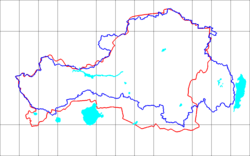Uryankhay Krai
Uryankhay Krai (Russian: Урянхайский край, Urjanchajskij kraj) was the name of what is today Tuva and was a short-lived protectorate of the Russian Empire that was proclaimed on 17 April 1914, created from the Urjanchai Republic which had recently proclaimed its independence from the Qing dynasty of China in the Mongolian Revolution of 1911.[1][2] After the February Revolution and abdication of Tsar Nicholas II, Uryankhay Krai recognized the new Russian Republic and reaffirmed its status as a Russian protectorate in 1917.[1][2]
Uryankhay Krai | |||||||||||
|---|---|---|---|---|---|---|---|---|---|---|---|
| 1914–1921 | |||||||||||
.svg.png) Flag | |||||||||||
 Blue line is the Uryankhay Krai's border. Red line is the Tuvan Autonomous Oblast (1953) border. | |||||||||||
| Status | Russian protectorate | ||||||||||
| Common languages | Tuvan Russian Chinese | ||||||||||
| Government | Protectorate | ||||||||||
| Amban Noyan | |||||||||||
• 1914–1915 | Oyun Ölzey-Ochur oglu Kombu-Dorzhu | ||||||||||
• 1915–1916 | Irgit Agbaan-Demchi | ||||||||||
• 1916–1921 | Oyun Kombu-Dorzhu oglu Sodunam-Balchyr | ||||||||||
| Historical era | Long nineteenth century | ||||||||||
• Established | 17 April 1914 | ||||||||||
• Became the People's Republic of Tannu Tuva | 14 August 1921 | ||||||||||
| |||||||||||
| Today part of | |||||||||||
During the Russian Civil War, the country was occupied by China and Russian "Whites" between 1918 and 1921. Supported by the Red Army, the Tuvan People's Revolutionary Party established the Soviet puppet state of the Tuvan People's Republic (initially Tannu Tuva) on 14 August 1921.[1][2]
References
- "RossTuva | ТЫВА Tuva". hubert-herald.nl. Retrieved 2018-08-25.
- Cahoon, Ben. "Tannu Tuva". worldstatesmen.org. Retrieved 8 August 2019.